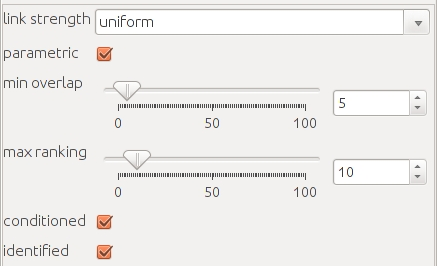Simmelian backbone extraction
Note: this page documents a visone functionality that will be available in the next release of visone (version 2.7, scheduled for May 2013) .
This network transformation is meant to simplify subsequent network visualizations and clustering calculations. It is based on local ranking and overlap calculations to extract a Simmelian backbone of strong and redundant ties. Detailed information is provided in
- Bobo Nick, Conrad Lee, Ulrik Brandes: "Simmelian Backbones: Amplifying Hidden Homophily in Facebook Networks", 2013; submitted.
Background information will also be presented in a talk at XXXIII Sunbelt Social Networks Conference of the International Network for Social Network Analysis (INSNA), Hamburg, Germany, May 21-26, 2013: Bobo Nick, Conrad Lee, Pádraig Cunningham, Ulrik Brandes: "Triadic Cohesion in Social Networks".
Please address questions and comments to Bobo Nick.
Where to find
Access is given via the transformation tab in the left-hand side of the visone window: set level to network and operation to Simmelian backbone.
Configuration
Ranking calculation
The Simmelian backbone is extracted from a ranked neighborhood graph. For this purpose, each undirected edge is split into two contrary directed edges, and the algorithm will rank each node's (outgoing) neighbors according to an associated (ordinal) link strength attribute.
- If uniform is selected (default), the algorithm will calculate a link strength attribute on its own (the Simmelian strength; saved as triadType300).
- Otherwise, the algorithm will use the attribute that was provided.
The resulting neighborhood rankings are saved in a link attribute termed ranking. Neighbors with equal link strength are equally ranked with the best available rank. (For technical reasons, if the selected link strength attribute is termed ranking or redundancy it will be renamed into backbone-weight (ranking) or backbone-weight (redundancy), respectively.)
Redundancy assessment
Next, for designated pairs of nodes, the algorithm will calculate the redundancy of top-ranked neighbors. Always, only the ranked neighborhoods of connected pairs of actors will be compared. That is, each overlap comparison is associated with a directed link. The resulting redundancy values are saved in a link attribute termed redundancy.
Parametric variant
If parametric is selected, the required redundancy for a link to be included in the Simmelian backbone is specified in terms of a necessary number of top-ranked common neighbors (regarding ego and alter associated with this link):
- You can use the max ranking parameter to specify the maximal rank which is still regarded as a top-rank. That is, those outgoing neighbors that have been attached a rank greater than max ranking will not contribute in the redundancy calculation.
- You can use the min overlap parameter to specify a minimal required overlap of top-ranked common neighbors.
- You can use the conditioned parameter to specify for which pairs of actors the overlap is calculated:
- if selected (default), the overlap calculation is only performed for those links which have been top-ranked themselves
- if deselected, the overlap calculation is performed for each directed link in the ranked neighborhood graph.
Special cases (allowing other functionality): Setting max ranking to zero will imply zero/undefined overlap values; thus, only the ranking functionality is used. If restricted is true, non-top-ranked links have undefined overlap values and will be removed accordingly; set restricted to false to avoid undefined overlap values. Setting min overlap to zero will imply that only links with undefined overlap value are removed from the network; thus, the filtering does only take into account the ranking.
Non-parametric variant
In the non-parametric variant of the transformation algorithm, a redundancy calculation is triggered for each link in the ranked neighborhood graph. The redundancy is defined as the maximum Jaccard coefficient that is reach when iteratively comparing top ranked neighbors (including more and more ranks). For a link to be included in the Simmelian backbone, the best found Jaccard coefficient has to be at least one half.
Assessment of reciprocity
For any of the two variants (parametric, or non-parametric redundancy assessment), you can decide whether ego is identified with alter in the redundancy calculations, i.e. reciprocity within top ranks is counted as overlap, or whether those entries in the ranked neighborhoods are not taken into account.
Result
For convenience, if layout is selected, visone's quick layout functionality is used to visualize the modified network structure at the end of the algorithm; otherwise, all node positions remain as before.
Use apply to to select the network(s) for which the calculations shall be performed. Since the network structure is altered by the algorithm, result in a new network rather than this network is proposed as default. The calculation is triggered by clicking the transform button at the bottom.


